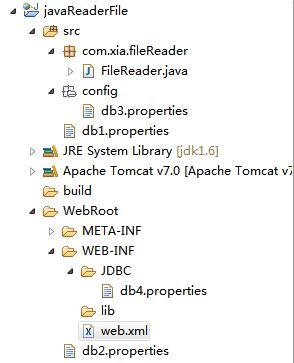这篇文章给大家分享的是有关JavaWeb如何读取配置文件的内容。小编觉得挺实用的,因此分享给大家做个参考,一起跟随小编过来看看吧。
方式一:采用ServletContext读取
获取配置文件的realpath,然后通过文件流读取出来或者通过方法getReasurceAsStream()。
因为是用ServletContext读取文件路径,所以配置文件可以放入在WEB-INF的classes目录中,也可以在应用层级及WEB-INF的目录中。文件存放位置具体在eclipse工程中的表现是:可以放在src下面,也可放在WEB-INF及Web-Root下面等。因为是读取出路径后,用文件流进行读取的,所以可以读取任意的配置文件包括xml和properties。缺点:不能在servlet外面应用读取配置信息。
1.首先创建一个动态的javaweb项目,项目目录如下:

2.创建一个servlet(FileReader.java)
package com.xia.fileReader; import java.io.FileInputStream; import java.io.IOException; import java.io.InputStream; import java.io.InputStreamReader; import java.text.MessageFormat; import java.util.Properties; import javax.servlet.ServletException; import javax.servlet.http.HttpServlet; import javax.servlet.http.HttpServletRequest; import javax.servlet.http.HttpServletResponse; public class FileReader extends HttpServlet { private static final long serialVersionUID = 1L; protected void doGet(HttpServletRequest request, HttpServletResponse response) throws ServletException, IOException { /** * response.setContentType("text/html;charset=UTF-8");目的是控制浏览器用UTF-8进行解码; * 这样就不会出现中文乱码了 */ response.setHeader("content-type","text/html;charset=UTF-8"); readSrcDirPropCfgFile(response);//读取src目录下的db1.properties配置文件 response.getWriter().println("<hr/>"); readWebRootDirPropCfgFile(response);//读取WebRoot目录下的db2.properties配置文件 response.getWriter().println("<hr/>"); readSrcSourcePackPropCfgFile(response);//读取src目录下的config目录中的db3.properties配置文件 response.getWriter().println("<hr/>"); readWEBINFPropCfgFile(response);//读取WEB-INF目录下的JDBC目录中的db4.properties配置文件 } public void readSrcDirPropCfgFile(HttpServletResponse response) throws IOException { String path = "/WEB-INF/classes/db1.properties"; InputStream in = this.getServletContext().getResourceAsStream(path); Properties props = new Properties(); props.load(in); String driver = props.getProperty("jdbc.driver"); String url = props.getProperty("jdbc.url"); String username = props.getProperty("jdbc.username"); String password = props.getProperty("jdbc.password"); response.getWriter().println("读取src目录下的db1.properties配置文件"); response.getWriter().println(MessageFormat.format( "driver={0},url={1},username={2},password={3}", driver,url, username, password)); } public void readWebRootDirPropCfgFile(HttpServletResponse response) throws IOException{ String path = "/db2.properties"; InputStream in = this.getServletContext().getResourceAsStream(path); Properties props = new Properties(); props.load(in); String driver = props.getProperty("jdbc.driver"); String url = props.getProperty("jdbc.url"); String username = props.getProperty("jdbc.username"); String password = props.getProperty("jdbc.password"); response.getWriter().println("读取WebRoot目录下的db2.properties配置文件"); response.getWriter().println(MessageFormat.format( "driver={0},url={1},username={2},password={3}", driver,url, username, password)); } public void readSrcSourcePackPropCfgFile(HttpServletResponse response) throws IOException { String path = "/WEB-INF/classes/config/db3.properties"; String realPath = this.getServletContext().getRealPath(path); InputStreamReader reader = new InputStreamReader(new FileInputStream(realPath),"UTF-8"); Properties props = new Properties(); props.load(reader); String driver = props.getProperty("jdbc.driver"); String url = props.getProperty("jdbc.url"); String username = props.getProperty("jdbc.username"); String password = props.getProperty("jdbc.password"); response.getWriter().println("读取src目录下的config目录中的db3.properties配置文件"); response.getWriter().println(MessageFormat.format( "driver={0},url={1},username={2},password={3}", driver,url, username, password)); } public void readWEBINFPropCfgFile(HttpServletResponse response) throws IOException { String path = "/WEB-INF/JDBC/db4.properties"; String realPath = this.getServletContext().getRealPath(path); System.out.println("realPath:"+realPath); System.out.println("contextPath:"+this.getServletContext().getContextPath()); InputStreamReader reader = new InputStreamReader(new FileInputStream(realPath),"UTF-8"); Properties props = new Properties(); props.load(reader); String driver = props.getProperty("jdbc.driver"); String url = props.getProperty("jdbc.url"); String username = props.getProperty("jdbc.username"); String password = props.getProperty("jdbc.password"); response.getWriter().println("读取WEB-INF目录下的JDBC目录中的db4.properties配置文件"); response.getWriter().println(MessageFormat.format( "driver={0},url={1},username={2},password={3}", driver,url, username, password)); } protected void doPost(HttpServletRequest request, HttpServletResponse response) throws ServletException, IOException { } }3.配置servlet(web.xml)
<?xml version="1.0" encoding="UTF-8"?> <web-app xmlns:xsi="http://www.w3.org/2001/XMLSchema-instance" xmlns="http://java.sun.com/xml/ns/javaee" xsi:schemaLocation="http://java.sun.com/xml/ns/javaee http://java.sun.com/xml/ns/javaee/web-app_3_0.xsd" id="WebApp_ID" version="3.0"> <display-name>javaReaderFile</display-name> <welcome-file-list> <welcome-file>index.html</welcome-file> <welcome-file>index.htm</welcome-file> <welcome-file>index.jsp</welcome-file> <welcome-file>default.html</welcome-file> <welcome-file>default.htm</welcome-file> <welcome-file>default.jsp</welcome-file> </welcome-file-list> <servlet> <servlet-name>FileReader</servlet-name> <servlet-class>com.xia.fileReader.FileReader</servlet-class> </servlet> <servlet-mapping> <servlet-name>FileReader</servlet-name> <url-pattern>/FileReader</url-pattern> </servlet-mapping> </web-app>
4.测试

方式二:采用ResourceBundle类读取配置信息
优点是:可以以完全限定类名的方式加载资源后,直接的读取出来,且可以在非Web应用中读取资源文件。
缺点:只能加载类src下面的资源文件且只能读取.properties文件。
/** * 获取指定配置文件中所有的数据 * @param propertyName * 调用方式: * 1.配置文件放在resource源包下,不用加后缀 * PropertiesUtil.getAllMessage("message"); * 2.放在包里面的 * PropertiesUtil.getAllMessage("com.test.message"); * @return */ public static List<String> getAllMessage(String propertyName) { // 获得资源包 ResourceBundle rb = ResourceBundle.getBundle(propertyName.trim()); // 通过资源包拿到所有的key Enumeration<String> allKey = rb.getKeys(); // 遍历key 得到 value List<String> valList = new ArrayList<String>(); while (allKey.hasMoreElements()) { String key = allKey.nextElement(); String value = (String) rb.getString(key); valList.add(value); } return valList; }方式三:采用ClassLoader方式进行读取配置信息
优点是:可以在非Web应用中读取配置资源信息,可以读取任意的资源文件信息
缺点:只能加载类src下面的资源文件,不适合装载大文件,否则会导致jvm内存溢出
package com.xia.fileReader; import java.io.BufferedReader; import java.io.IOException; import java.io.InputStream; import java.io.InputStreamReader; import java.util.Properties; public class ReadByClassLoader { public static void main(String[] args) throws IOException { readPropFileByClassLoad(); } public static void readPropFileByClassLoad() throws IOException{ //读取src下面config包内的配置文件db3.properties InputStream in = ReadByClassLoader.class.getClassLoader().getResourceAsStream("config/db3.properties"); BufferedReader br = new BufferedReader(new InputStreamReader(in)); Properties props = new Properties(); props.load(br); for(Object s: props.keySet()){ System.out.println(s+":"+props.getProperty(s.toString())); } } }方式四: PropertiesLoaderUtils工具类
/** * Spring 提供的 PropertiesLoaderUtils 允许您直接通过基于类路径的文件地址加载属性资源 * 最大的好处就是:实时加载配置文件,修改后立即生效,不必重启 */ private static void springUtil(){ Properties props = new Properties(); while(true){ try { props=PropertiesLoaderUtils.loadAllProperties("message.properties"); for(Object key:props.keySet()){ System.out.print(key+":"); System.out.println(props.get(key)); } } catch (IOException e) { System.out.println(e.getMessage()); } try {Thread.sleep(5000);} catch (InterruptedException e) {e.printStackTrace();} } }修改Properties
/** * 传递键值对的Map,更新properties文件 * * @param fileName * 文件名(放在resource源包目录下),需要后缀 * @param keyValueMap * 键值对Map */ public static void updateProperties(String fileName,Map<String, String> keyValueMap) { //getResource方法使用了utf-8对路径信息进行了编码,当路径中存在中文和空格时,他会对这些字符进行转换,这样, //得到的往往不是我们想要的真实路径,在此,调用了URLDecoder的decode方法进行解码,以便得到原始的中文及空格路径。 String filePath = PropertiesUtil.class.getClassLoader().getResource(fileName).getFile(); Properties props = null; BufferedWriter bw = null; try { filePath = URLDecoder.decode(filePath,"utf-8"); log.debug("updateProperties propertiesPath:" + filePath); props = PropertiesLoaderUtils.loadProperties(new ClassPathResource(fileName)); log.debug("updateProperties old:"+props); // 写入属性文件 bw = new BufferedWriter(new OutputStreamWriter(new FileOutputStream(filePath))); props.clear();// 清空旧的文件 for (String key : keyValueMap.keySet()) props.setProperty(key, keyValueMap.get(key)); log.debug("updateProperties new:"+props); props.store(bw, ""); } catch (IOException e) { log.error(e.getMessage()); } finally { try { bw.close(); } catch (IOException e) { e.printStackTrace(); } } }感谢各位的阅读!关于“JavaWeb如何读取配置文件”这篇文章就分享到这里了,希望以上内容可以对大家有一定的帮助,让大家可以学到更多知识,如果觉得文章不错,可以把它分享出去让更多的人看到吧!
免责声明:本站发布的内容(图片、视频和文字)以原创、转载和分享为主,文章观点不代表本网站立场,如果涉及侵权请联系站长邮箱:is@yisu.com进行举报,并提供相关证据,一经查实,将立刻删除涉嫌侵权内容。